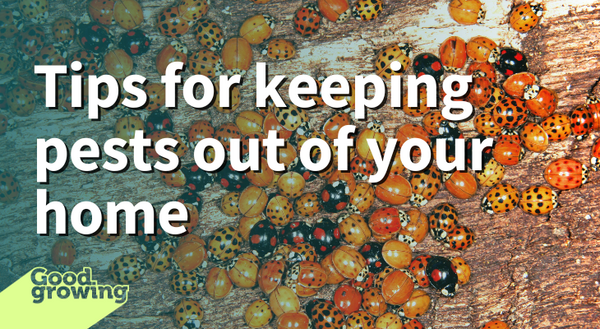
With the arrival of fall, many of us will be heading outdoors for various activities, from visiting the local pumpkin patch or apple orchard, attending football games, or enjoying fall colors. People aren’t the only thing on the move, though. As the weather gets colder and the days get shorter, uninvited guests often show up in our homes. A variety of insects and other creepy crawlies begin seeking shelter to pass the winter and occasionally end up indoors. Taking a little time out of your busy fall schedule to pest-proof your house now can help keep those pesky pests outdoors.
Looking for somewhere to spend the winter
As temperatures begin to drop, many insects will seek places to spend the winter. Insects (and other arthropods) look for sheltered locations that have consistent, stable temperatures (no big temperature swings) where they can remain throughout the winter.
Insects are often attracted to buildings with large southern or western exposures because they are warmer than the surrounding area. As they aggregate on buildings, they will find cracks, crevices, and other spaces to squeeze into. They may also make their way indoors and often end up in exterior wall voids and attics until warm weather returns.
Insects that make their way further indoors usually don’t survive long. Temperatures indoors are usually too warm for insects to go into hibernation. With little to no food around for them, they will eventually die. Some insects we commonly see aggregating on buildings are box elder bugs, multicolored Asian lady beetles, and brown marmorated stink bugs.
Other critters that may find their way indoors include crickets, pillbugs (roly-polies), earwigs, millipedes, and springtails. These insects typically live in dark, damp areas and may accidentally make their way indoors, looking for warmer conditions or in the soil of plants brought indoors. Due to dry conditions in our homes, these insects rarely survive long.
Keeping critters out of the house
As the saying goes, an ounce of prevention is worth a pound of cure. The best management strategy is to keep them out of your home in the first place (exclusion). Taking some time to ‘pest-proof’ your home can keep many unwanted guests from getting indoors.
- Caulk cracks around doors, windows, vents, etc.
- Make sure exterior doors are properly sealed. You should not be able to feel air blowing around a door or see light doors. Make sure exterior doors have door sweeps and they touch the ground. Lie on the floor and look for light underneath doors. Gaps as small as 1/16 inch can allow insects and spiders to enter buildings, and gaps of ¼ are big enough for mice to get in. Make sure to check garage doors and sliding doors, too.
- Seal any openings, cracks, and crevices around the foundation and chimneys, as well as openings where pipes and wires enter buildings. Use caulk, cement, expandable foam, steel wool, or other suitable materials.
- Check siding, eaves, and soffits and ensure they are in good condition. Repair or replace as needed.
- Repair or replace torn or damaged window screens. Some insects, like hackberry psyllids, are small enough to fight through window screens, so windows will need to be closed to try and keep them out.
- An insecticide barrier can be applied to the exterior of homes. Make sure to read and follow all label directions.
Good Growing tip of the week: We may unknowingly bring insects into our homes. In addition to hitching a ride on plants, insects can also be introduced into homes in birdseed, dry pet food, dry food products (rice, pasta, flour, etc.), and dried plant materials (dried flower arrangements, ornamental corn, etc.) in the form of pantry pests.
Resources and for more information
Potter, Michael F. “How to Pest-Proof Your Home .” University of Kentucky. Accessed September 25, 2023. https://entomology.ca.uky.edu/ef641.
Signup for our emails! Want to get notified when new Good Growing posts are available? SIGN ME UP
MEET THE AUTHOR
Ken Johnson is a Horticulture Educator with University of Illinois Extension, serving Calhoun, Cass, Greene, Morgan, and Scott counties since 2013. Ken provides horticulture programming with an emphasis on fruit and vegetable production, pest management, and beneficial insects. Through his programming, he aims to increase backyard food production and foster a greater appreciation of insects.